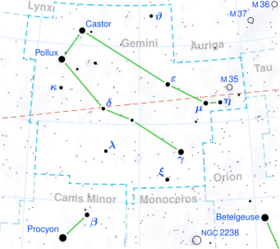Astronomy:Omega Geminorum
| Observation data Equinox J2000.0]] (ICRS) | |
|---|---|
| Constellation | Gemini |
| Right ascension | 07h 02m 24.78033s[1] |
| Declination | +24° 12′ 55.6051″[1] |
| Apparent magnitude (V) | 5.18[2] |
| Characteristics | |
| Spectral type | G5 II[3] |
| U−B color index | +0.68[2] |
| B−V color index | +0.95[2] |
| Variable type | Cepheid?[4] |
| Astrometry | |
| Radial velocity (Rv) | −9.10±0.40[5] km/s |
| Proper motion (μ) | RA: −6.74[1] mas/yr Dec.: -0.25[1] mas/yr |
| Parallax (π) | 2.19 ± 0.26[1] mas |
| Distance | approx. 1,500 ly (approx. 460 pc) |
| Absolute magnitude (MV) | −3.06[6] |
| Details | |
| Mass | 6.3±0.5[3] M☉ |
| Radius | 72[7] R☉ |
| Luminosity | 1,813[8] L☉ |
| Surface gravity (log g) | 2.45[9] cgs |
| Temperature | 5,090[9] K |
| Metallicity [Fe/H] | −0.02[9] dex |
| Rotational velocity (v sin i) | 10[10] km/s |
| Age | 14.8[3] Myr |
| Other designations | |
| Database references | |
| SIMBAD | data |
Omega Geminorum, Latinized from ω Geminorum, is a star located in the middle of the northern zodiac constellation of Gemini. With an apparent visual magnitude of 5.18,[2] it is faintly visible to the naked eye. According to the Bortle scale, it can be viewed from dark suburban skies. With an annual parallax shift of just 2.19 mas,[1] it is located about 1,500 light years from the Sun.
This is an evolved bright giant star with a stellar classification of G5 II.[3] It is positioned near the instability strip and in 1977 was listed as a candidate cepheid variable star[12] with a luminosity amplitude of 0.086 and a period of 0.7282 days.[4] The interferometer-measured angular diameter of this star is 1.47±0.21 mas.[13] At its estimated distance, this yields a physical size of about 72 times the radius of the Sun.[7] It has 6.3[3] times the mass of the Sun and radiates 1,813[8] times the solar luminosity from its outer atmosphere at an effective temperature of 5,090 K.[9]
References
- ↑ 1.0 1.1 1.2 1.3 1.4 1.5 van Leeuwen, F. (2007), "Validation of the new Hipparcos reduction", Astronomy and Astrophysics 474 (2): 653–664, doi:10.1051/0004-6361:20078357, Bibcode: 2007A&A...474..653V.
- ↑ 2.0 2.1 2.2 2.3 Argue, A. N. (1966), "UBV photometry of 550 F, G and K type stars", Monthly Notices of the Royal Astronomical Society 133 (4): 475–493, doi:10.1093/mnras/133.4.475, Bibcode: 1966MNRAS.133..475A.
- ↑ 3.0 3.1 3.2 3.3 3.4 Tetzlaff, N. et al. (January 2011), "A catalogue of young runaway Hipparcos stars within 3 kpc from the Sun", Monthly Notices of the Royal Astronomical Society 410 (1): 190–200, doi:10.1111/j.1365-2966.2010.17434.x, Bibcode: 2011MNRAS.410..190T.
- ↑ 4.0 4.1 Henriksson, G. (January 1977), "Low amplitude variable stars", Astronomy and Astrophysics 54: 309–310, Bibcode: 1977A&A....54..309H.
- ↑ de Bruijne, J. H. J.; Eilers, A.-C. (October 2012), "Radial velocities for the HIPPARCOS-Gaia Hundred-Thousand-Proper-Motion project", Astronomy & Astrophysics 546: 14, doi:10.1051/0004-6361/201219219, A61, Bibcode: 2012A&A...546A..61D.
- ↑ Anderson, E.; Francis, Ch. (2012), "XHIP: An extended hipparcos compilation", Astronomy Letters 38 (5): 331, doi:10.1134/S1063773712050015, Bibcode: 2012AstL...38..331A.
- ↑ 7.0 7.1 Lang, Kenneth R. (2006), Astrophysical formulae, Astronomy and astrophysics library, 1 (3rd ed.), Birkhäuser, ISBN 3-540-29692-1, https://books.google.com/books?id=OvTjLcQ4MCQC&pg=PA41. The radius (R*) is given by:
- [math]\displaystyle{ \begin{align} 2\cdot R_* & = \frac{(457\cdot 1.47\cdot 10^{-3})\ \text{AU}}{0.0046491\ \text{AU}/R_{\bigodot}} \\ & \approx 144\cdot R_{\bigodot} \end{align} }[/math]
- ↑ 8.0 8.1 McDonald, I. et al. (2012), "Fundamental Parameters and Infrared Excesses of Hipparcos Stars", Monthly Notices of the Royal Astronomical Society 427 (1): 343–57, doi:10.1111/j.1365-2966.2012.21873.x, Bibcode: 2012MNRAS.427..343M.
- ↑ 9.0 9.1 9.2 9.3 Kovtyukh, V. V. et al. (September 2008), "Reddenings of FGK supergiants and classical Cepheids from spectroscopic data", Monthly Notices of the Royal Astronomical Society 389 (3): 1336–1344, doi:10.1111/j.1365-2966.2008.13644.x, Bibcode: 2008MNRAS.389.1336K.
- ↑ Bernacca, P. L.; Perinotto, M. (1970), "A catalogue of stellar rotational velocities", Contributi Osservatorio Astronomico di Padova in Asiago 239 (1): 1, Bibcode: 1970CoAsi.239....1B.
- ↑ "ome Gem -- Cepheid variable Star", SIMBAD Astronomical Database (Centre de Données astronomiques de Strasbourg), http://simbad.u-strasbg.fr/simbad/sim-id?Ident=ome+Gem, retrieved 2016-12-09.
- ↑ Gorynya, N. A. et al. (November 1998), "A catalog of Cepheid radial velocities measured in 1995-1998 with the correlation spectrometer", Astronomy Letters 24 (6): 815–818, Bibcode: 1998AstL...24..815G.
- ↑ Richichi, A. et al. (February 2005), "CHARM2: An updated Catalog of High Angular Resolution Measurements", Astronomy and Astrophysics 431 (2): 773–777, doi:10.1051/0004-6361:20042039, Bibcode: 2005A&A...431..773R
External links
- Kaler, James B., "Omega Geminorum", Stars (University of Illinois), http://stars.astro.illinois.edu/sow/omegagem.html, retrieved 2016-12-10.
 |


